 The past three days have been dedicated to meetings and surveying of the heritage sites of San Fernando. We are one in a rare breed of cities in the country which are agressively pursuing heritage conservation. On Wednesday, we met with representatives of the San Fernando, Pampanga Heritage Foundation, Filipino-American Memorial Endowment, American Chamber of Commerce, Battling Bastards of Bataan and the Defenders of Bataan and Corregidor regarding the plans of the city to restore the San Fernando Train Station and to open a Death March memorial and museum in the site.
The past three days have been dedicated to meetings and surveying of the heritage sites of San Fernando. We are one in a rare breed of cities in the country which are agressively pursuing heritage conservation. On Wednesday, we met with representatives of the San Fernando, Pampanga Heritage Foundation, Filipino-American Memorial Endowment, American Chamber of Commerce, Battling Bastards of Bataan and the Defenders of Bataan and Corregidor regarding the plans of the city to restore the San Fernando Train Station and to open a Death March memorial and museum in the site.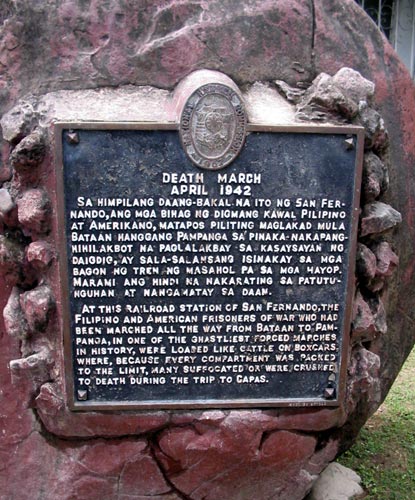 For those who are not yet aware of the significance of the said train station, it was the ending point of the long 102-kilometer walk from Mariveles, Bataan in April 1942. At the station, thousands of Filipino and American POWs were stuffed like sardines into box carts and transported to Capas, Tarlac. Anyway, expect more updates but the biggest hurdle is the slow response of the Philippine National Railways Corporation which is the owner of the said property.Yesterday was my rest day. I spent my 27th at home sleeping. Hehe! I decided that the best way for me to celebrate was to give myself the rest I badly needed.
For those who are not yet aware of the significance of the said train station, it was the ending point of the long 102-kilometer walk from Mariveles, Bataan in April 1942. At the station, thousands of Filipino and American POWs were stuffed like sardines into box carts and transported to Capas, Tarlac. Anyway, expect more updates but the biggest hurdle is the slow response of the Philippine National Railways Corporation which is the owner of the said property.Yesterday was my rest day. I spent my 27th at home sleeping. Hehe! I decided that the best way for me to celebrate was to give myself the rest I badly needed.  Today, a survey team of the National Historical Institute arrived to inspect more houses for possible declaration. San Fernando is trying to increase its number of declared structures and glad to say, all the other house owners have already given their consent and are excited about the possible declaration. For one, the city will soon be granting real estate tax exemptions to all heritage house owners to encourage them to preserve their homes.
Today, a survey team of the National Historical Institute arrived to inspect more houses for possible declaration. San Fernando is trying to increase its number of declared structures and glad to say, all the other house owners have already given their consent and are excited about the possible declaration. For one, the city will soon be granting real estate tax exemptions to all heritage house owners to encourage them to preserve their homes. Among the strongest contenders is the Singian House which was built in the mid-19th century. It could in fact be the oldest surviving house in San Fernando. The house is very well-maintained by its current owners. If it was indeed built in the 1850s, I suspect its original owner was Don Bernardino Singian de Miranda, a former gobernadorcillo of San Fernando from whom many of San Fernando's prominent families trace their roots. Don Bernardino is the grandfather of eminent pre-war surgeon Dr. Gregorio Singian.Beside the house is a really large camalig which is very well-preserved also. Structures like these form part of the industrial heritage of the city and are a rarity nowadays.
Among the strongest contenders is the Singian House which was built in the mid-19th century. It could in fact be the oldest surviving house in San Fernando. The house is very well-maintained by its current owners. If it was indeed built in the 1850s, I suspect its original owner was Don Bernardino Singian de Miranda, a former gobernadorcillo of San Fernando from whom many of San Fernando's prominent families trace their roots. Don Bernardino is the grandfather of eminent pre-war surgeon Dr. Gregorio Singian.Beside the house is a really large camalig which is very well-preserved also. Structures like these form part of the industrial heritage of the city and are a rarity nowadays. Another strong contender is the charming Victorian-inspired Hizon House along Consunji Street. It was built by Don Teodoro Santos, Jr. and Dona Africa Ventura and later purchased by Maria Hizon who served as a nurse in the Philippine Revolutionary Army. It is currently owned by the heirs of her nephew, Don Augusto Hizon.There are more candidates in the list. But it's all up to the NHI Board which has the final say. This however may take longer than it used to since I heard the board rarely convenes for meetings. Sigh!I guess that's it for now. To learn more about the heritage sites in San Fernando, click here.
Another strong contender is the charming Victorian-inspired Hizon House along Consunji Street. It was built by Don Teodoro Santos, Jr. and Dona Africa Ventura and later purchased by Maria Hizon who served as a nurse in the Philippine Revolutionary Army. It is currently owned by the heirs of her nephew, Don Augusto Hizon.There are more candidates in the list. But it's all up to the NHI Board which has the final say. This however may take longer than it used to since I heard the board rarely convenes for meetings. Sigh!I guess that's it for now. To learn more about the heritage sites in San Fernando, click here.
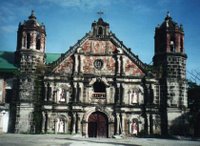 In the Kapampangan language, churches are called pisamban. One of the very first websites I made way back in college was on the churches of Pampanga. I remember that I spent two weeks traveling around the province of Pampanga searching for its heritage sites. At that time, there was no inventory of heritage sites. And the information and photos I collected eventually became the jump off point for the heritage conservation campaign in Pampanga.This I made available on the net through the website Pisamban: Churches of Pampanga (as of October 2009, Geocities is no longer online) among others. I was no longer able to update it since the files were lost when my computer crashed several years back. Above is a photo of the Minalin Church while the one below can be found in San Luis. Anyway, there are more photos of Pampanga and San Fernando heritage churches and other structures in my Yahoo! Photos.
In the Kapampangan language, churches are called pisamban. One of the very first websites I made way back in college was on the churches of Pampanga. I remember that I spent two weeks traveling around the province of Pampanga searching for its heritage sites. At that time, there was no inventory of heritage sites. And the information and photos I collected eventually became the jump off point for the heritage conservation campaign in Pampanga.This I made available on the net through the website Pisamban: Churches of Pampanga (as of October 2009, Geocities is no longer online) among others. I was no longer able to update it since the files were lost when my computer crashed several years back. Above is a photo of the Minalin Church while the one below can be found in San Luis. Anyway, there are more photos of Pampanga and San Fernando heritage churches and other structures in my Yahoo! Photos. Just to update everyone regarding our petition to the CBCP, we've collected more than 500 signatures to date and more are still coming in. It has been gaining so much momentum, international attention and support is pouring in as well. We have received letters of support from international conservation agencies such as the World Monuments Fund, the International Council on Monuments and Sites (ICOMOS) and its various national committees worldwide, and the Partners for Sacred Places among many others. If you haven't signed yet, please do at http://www.petitiononline.com/cbcp.
Just to update everyone regarding our petition to the CBCP, we've collected more than 500 signatures to date and more are still coming in. It has been gaining so much momentum, international attention and support is pouring in as well. We have received letters of support from international conservation agencies such as the World Monuments Fund, the International Council on Monuments and Sites (ICOMOS) and its various national committees worldwide, and the Partners for Sacred Places among many others. If you haven't signed yet, please do at http://www.petitiononline.com/cbcp.
The Vatican actually has a Pontifical Commission for the Cultural Heritage of the Church. In a 2001 circular letter, its president His Eminence Francesco Cardinal Marchisano says, "The cultural treasures of the Church make up the specific patrimony of the Christian community. At the same time, as a result of the universal dimension of the Christian message, they belong to the whole of humanity. Their end is the same as the Church's mission in its twofold work of Christian evangelization and promoting the human being. Their value lies in highlighting the activity of inculturating the faith. (emphasis mine)"
He adds, “The value that the Church places on her cultural goods explains ‘the will on the part of the community of faithful, and in particular ecclesiastical institutions, to gather since the apostolic period the testimonies of faith and nourish their memory, express the uniqueness and continuity of the Church that lives out these last periods of history’ (Pontifical Commission for the Cultural Heritage of the Church, Circular Letter The Pastoral Function of Church Archives, see n. 1.1.). Thus, the Church considers as crucial the handing down of her own patrimony of cultural goods. They represent, in fact, an essential link in the chain of Tradition; they are the visible memory of evangelization; they become a pastoral instrument. It follows therefore the effort ‘to restore, preserve, catalogue, and protect’ them (John Paul II, Address of October 12, 1995, see n. 4) in order to assure that they are treasured, ‘thus promoting a greater knowledge and suitable use in catechesis and in the liturgy’ (ibid.). (emphasis mine again)”
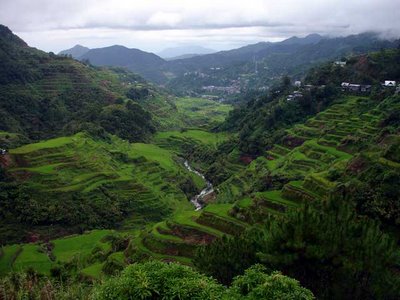 Just got back from an exhausting but fulfilling day trip to the Cordilleras. Yes, you heard me right, it was a day trip! This time the HCS was off to Bontoc, Mountain Province where a rare American period upland capitol building still stands.We all met up at Gemma's place at 11 p.m. Saturday night and were off at about 12 midnight. It was going to be a long drive up Maharlika Highway so we went to sleep for most of the trip stopping only for a short break in Bambang, Nueva Vizcaya. In Baliuag, we were caught in a major traffic jam in the brewing since an AUV had crashed into a telephone post and as a result, the wires were dangling quite low making it difficult for trucks to pass. Since it is a major truck route, imagine the long line that resulted from the accident. Anyway, we were able to manuever our way in just a few minutes but we could imagine the traffic jam we were to face if we had arrived minutes later.
Just got back from an exhausting but fulfilling day trip to the Cordilleras. Yes, you heard me right, it was a day trip! This time the HCS was off to Bontoc, Mountain Province where a rare American period upland capitol building still stands.We all met up at Gemma's place at 11 p.m. Saturday night and were off at about 12 midnight. It was going to be a long drive up Maharlika Highway so we went to sleep for most of the trip stopping only for a short break in Bambang, Nueva Vizcaya. In Baliuag, we were caught in a major traffic jam in the brewing since an AUV had crashed into a telephone post and as a result, the wires were dangling quite low making it difficult for trucks to pass. Since it is a major truck route, imagine the long line that resulted from the accident. Anyway, we were able to manuever our way in just a few minutes but we could imagine the traffic jam we were to face if we had arrived minutes later.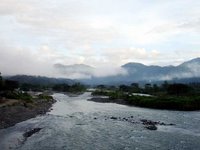 From Maharlika Highway, we made a left in Bagabag towards Banaue. By the time we entered Ifugao, the sun was up. The scenery along the way was just surreal and we had wanted to stopover by a river for a breakfast picnic but had to abandon the plan since it was difficult to find our way down to the riverbank. We had made it past Lagawe, Ifugao's capital town when we decided to find a spot along the mountain road for our picnic.
From Maharlika Highway, we made a left in Bagabag towards Banaue. By the time we entered Ifugao, the sun was up. The scenery along the way was just surreal and we had wanted to stopover by a river for a breakfast picnic but had to abandon the plan since it was difficult to find our way down to the riverbank. We had made it past Lagawe, Ifugao's capital town when we decided to find a spot along the mountain road for our picnic.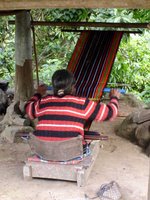 We found a clearing where we parked. Gemma had prepared cold cuts, bread, cheese, and steamed brussel sprouts and carrots, a healthy treat indeed! Then we noticed we had a flat tire. And to make things worse, there was one stubborn screw which broke our tire wrench. So the driver had to hitchhike to Banaue to look for a vulcanizing shop for help. Anyway, we were stuck for close to two hours. And by this time, Gemma had sent an SOS to the governor of Mountain Province. So a vehicle was on the way. But Bontoc was two hours away! So we just enjoyed the view and watched an old Ifugao lady weave some cloth the traditional way.
We found a clearing where we parked. Gemma had prepared cold cuts, bread, cheese, and steamed brussel sprouts and carrots, a healthy treat indeed! Then we noticed we had a flat tire. And to make things worse, there was one stubborn screw which broke our tire wrench. So the driver had to hitchhike to Banaue to look for a vulcanizing shop for help. Anyway, we were stuck for close to two hours. And by this time, Gemma had sent an SOS to the governor of Mountain Province. So a vehicle was on the way. But Bontoc was two hours away! So we just enjoyed the view and watched an old Ifugao lady weave some cloth the traditional way.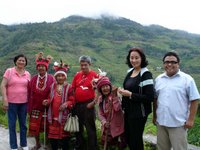 When the driver came back, they were able to replace the tire only to realize that the spare was soft as well. Oh brother! So we made a slow drive to Banaue where we had the tire inflated, pausing briefly for photos with the Banaue Rice Terraces. Sad to say, the view from Banaue town is now that of the Banaue House Terraces! Sigh! And you have to drive further out of town for better views. I wonder why the local government of Banaue did not regulate the construction and development in their area. Didn't they realize that they themselves are destroying the beauty of the rice terraces they are promoting to tourists?
When the driver came back, they were able to replace the tire only to realize that the spare was soft as well. Oh brother! So we made a slow drive to Banaue where we had the tire inflated, pausing briefly for photos with the Banaue Rice Terraces. Sad to say, the view from Banaue town is now that of the Banaue House Terraces! Sigh! And you have to drive further out of town for better views. I wonder why the local government of Banaue did not regulate the construction and development in their area. Didn't they realize that they themselves are destroying the beauty of the rice terraces they are promoting to tourists?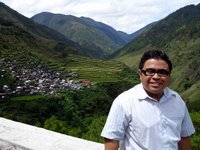 A few kilometers from Banaue, we finally saw the vehicle sent by the governor and decided to transfer. Since the driver was already used to driving along the rough mountain road, we were moving faster now. Of course, we could not resist the photo opportunities along the way, views of mountain villages such as Bayyo, perched beside the rice terraces which their ancestors built. Then we saw Bontoc, the capital town which appeared like a hidden metropolis in the mountains. It's sad though that the current architecture in the Philippines is so nondescript and lacks character. The view of Bontoc would have been more charming if the architectural character of the place was maintained.
A few kilometers from Banaue, we finally saw the vehicle sent by the governor and decided to transfer. Since the driver was already used to driving along the rough mountain road, we were moving faster now. Of course, we could not resist the photo opportunities along the way, views of mountain villages such as Bayyo, perched beside the rice terraces which their ancestors built. Then we saw Bontoc, the capital town which appeared like a hidden metropolis in the mountains. It's sad though that the current architecture in the Philippines is so nondescript and lacks character. The view of Bontoc would have been more charming if the architectural character of the place was maintained.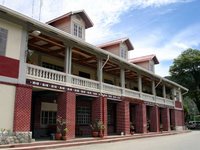 We went straight to the capitol to take photos for our 2007 HCS Calendar. The facade of the capitol had just been renovated in April, the wooden windows replace by metal ones. Sigh! But most of it was still intact. So we took our photos.Governor Maximo Dalog, who had graciously sent his vehicle to rescue us, was there to meet us. Inside his office, he served us native coffee and patupat, their native rice cake which was shaped into small triangles. We stayed in his office for quite a while since Gemma interviewed him for her TV and radio show.
We went straight to the capitol to take photos for our 2007 HCS Calendar. The facade of the capitol had just been renovated in April, the wooden windows replace by metal ones. Sigh! But most of it was still intact. So we took our photos.Governor Maximo Dalog, who had graciously sent his vehicle to rescue us, was there to meet us. Inside his office, he served us native coffee and patupat, their native rice cake which was shaped into small triangles. We stayed in his office for quite a while since Gemma interviewed him for her TV and radio show.
We had lunch at the Cable Cafe & Restaurant which was located in an old upland house. You could see the difference between the lowland and upland dwellings and sadly, there are not much of these colonial mountain homes and shophouses left. Before lunch, we were treated to an impromptu wine-tasting session as various lang-ay festival wines were brought out. They served us sorelle (cacao), bugnay and rice wines which were really great! I mixed some bugnay and sorelle wine with my pineapple juice and the result was a delicious cocktail which Gemma named Bontoc Embrace. Hehe!
 After the hearty lunch, we were brought to the Bontoc Museum which was housed in buildings designed like Bontoc huts. Right beside it was an old Catholic school founded in 1911, the St. Vincent's Elementary School which was a complex of wooden and brick buildings (more photos here). I had noticed a sign which showed a new building and fund-raising efforts for it. So I asked where it was going to be built. And to my horror, they were going to demolish some old ones.
After the hearty lunch, we were brought to the Bontoc Museum which was housed in buildings designed like Bontoc huts. Right beside it was an old Catholic school founded in 1911, the St. Vincent's Elementary School which was a complex of wooden and brick buildings (more photos here). I had noticed a sign which showed a new building and fund-raising efforts for it. So I asked where it was going to be built. And to my horror, they were going to demolish some old ones.
So I immediately talked to the governor and it turned out that the tourism officer who was with us was the president of the parents' association of the school. So we were able to make them realize the value of the old buildings and they will be contacting some heritage architects for advise on how to go about restoring them.
 Our plan was to visit nearby Sagada and Maligcong Rice Terraces but thanks to our flat tire fiasco, we had to make our way back to Manila. Sigh! This time, we stopped along the road for more photos. Despite the rough road which the governor calls the "Bontoc Massage," the view of the natural heritage of the Philippines at its finest makes any trip up the Cordilleras most worth it. I hope it stays that way!
Our plan was to visit nearby Sagada and Maligcong Rice Terraces but thanks to our flat tire fiasco, we had to make our way back to Manila. Sigh! This time, we stopped along the road for more photos. Despite the rough road which the governor calls the "Bontoc Massage," the view of the natural heritage of the Philippines at its finest makes any trip up the Cordilleras most worth it. I hope it stays that way!
One of our last stops was the marker of the Philippine Institute of Civil Engineers and the American Society of Civil Engineers (more photos here). Aside from being a National Cultural Treasure and a UNESCO World Heritage Site, the Ifugao Rice Terraces had also been designated as an International Historic Civil Engineering Landmark. So that is more reason to preserve it, moreso since it was among the 100 Most Endagered Sites for 2000, and still among 34 sites listed in the World Heritage in Danger List.
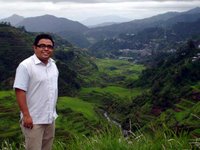 This marked viewpoint offers one of the better views of the rice terraces in Banaue. I think this viewpoint was the highlight of our trip thanks to the magnificent view and the cool mountain weather. From there, we proceeded to the Banaue Hotel where we had some coffee.
This marked viewpoint offers one of the better views of the rice terraces in Banaue. I think this viewpoint was the highlight of our trip thanks to the magnificent view and the cool mountain weather. From there, we proceeded to the Banaue Hotel where we had some coffee.
After coffee, it was off to Manila and another long nap. And we thought it was all over when we realized when we stopped over in Cabanatuan that our aircon fanbelt was broken. Good thing the weather was cool so the trip back to Manila wasn't that uncomfortable and the next thing I knew, we were back in Makati, a little over 24 hours after we had departed. It's now time to get more sleep! Hehe!
I just made a petition to the Catholic Bishops Conference of the Philippines (CBCP). To read and sign the petition, please visit http://www.petitiononline.com/cbcp. To check out who's signed the petition and what they have to say, click here.
A Filipino society that values and preserves its cultural heritage in order to instill pride of place and strengthen Philippine national identity... we can all make a big difference in our fight to preserve our cultural heritage!
I was on my own today since the heritage sites I was going to visit next were in Camarines Sur, particularly those along the Pacific coast in the southeastern part of the province around Lagonoy Gulf. And I was going to take the road less-traveled, a short cut from Tiwi to Sagñay, Camarines Sur which few people use. It was so remote and rarely used in fact that only one jeep plied the route leaving Tiwi only three times a day at 7 a.m., 9 a.m. and 1 p.m.
I set the alarm at 4:30 a.m. but I was just too tired so the next thing I knew, the caretaker of the guesthouse was knocking at my door at 5:15 a.m. Good thing I told him I planned to leave early. I took a jeep to the central terminal from outside the guesthouse, that was PHP7.50. At the terminal, there were FX taxicabs to various towns around Albay, Tiwi included. But after waiting for thirty minutes, still not much passengers and I was worried I would not make it in time for the 9 a.m. departure from Tiwi. So I heeded the advice of one of the dispatchers that I take a bus to Tabaco City where jeeps to Tiwi left regularly. Good thing I did since when I arrived in Tabaco, I was easily led to a jeep to Tiwi.
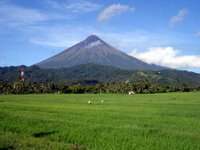 I made sure I sat on the left side of the bus as it offered the best views of Mayon Volcano. The mountain was nice to me today since there was not a single cloud in sight and I got to see about 180 degrees of it. The ordinary bus to Tabaco from Legazpi was just PHP20. While the jeep from Tabaco to Tiwi was PHP15.50. I arrived in Tiwi at about 8:30 a.m.
I made sure I sat on the left side of the bus as it offered the best views of Mayon Volcano. The mountain was nice to me today since there was not a single cloud in sight and I got to see about 180 degrees of it. The ordinary bus to Tabaco from Legazpi was just PHP20. While the jeep from Tabaco to Tiwi was PHP15.50. I arrived in Tiwi at about 8:30 a.m.
The jeep actually goes as far as Tigaon. The cost of the jeep from Tiwi to Sagñay was PHP45 for the approximately one and a half hour ride that took us along a road in surprisingly good condition that zigzagged high up on cliffs that hugged the Pacific coastline of Bicol, offering breathtaking views of the black sand beaches and outlying emerald colored islands. It was a pity I couldn't tell the jeep to stop so that I could take photos. In Sagñay (pronounced Sangay), I went straight to the church. I was met by a CAT troop complete with a marching band practicing for a parade of sorts. Nice! The church was a little altered outside but still ok. When I got inside, I saw that an upcoming renovation was in the works as seen from the billboard. They plan to make the interior to look like that of the St. Peter's Basilica. We need to educate our priests and parish pastoral councils that Philippine religious art is unique, its elegance in its folksy simplicity.
In Sagñay (pronounced Sangay), I went straight to the church. I was met by a CAT troop complete with a marching band practicing for a parade of sorts. Nice! The church was a little altered outside but still ok. When I got inside, I saw that an upcoming renovation was in the works as seen from the billboard. They plan to make the interior to look like that of the St. Peter's Basilica. We need to educate our priests and parish pastoral councils that Philippine religious art is unique, its elegance in its folksy simplicity.
From Sagñay, I took a quick motorbike ride to the next town Tigaon which was PHP15. Nice facade which I heard was funded by a family in the 1930s from money then won in the Sweepstakes. But again, when I got inside, another billboard announcing the need for P10.8 million! The church was also up for renovation.
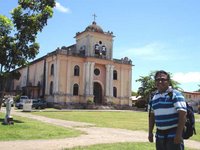 From the detailed plans, it showed they were going to replace the original clay tiles with granite. That component alone was a million pesos! I didn't see the need to change the flooring. It was an unnecessary and ostentatious expense that would make happy only the contractors and the priest whose whims and caprices were satisfied. Such money which priests extract from the townsfolk through all this fundraising hullabaloo could be used for the real pastoral mission of the Church which is definitely not construction.
From the detailed plans, it showed they were going to replace the original clay tiles with granite. That component alone was a million pesos! I didn't see the need to change the flooring. It was an unnecessary and ostentatious expense that would make happy only the contractors and the priest whose whims and caprices were satisfied. Such money which priests extract from the townsfolk through all this fundraising hullabaloo could be used for the real pastoral mission of the Church which is definitely not construction.
I talked to the parish priest but you could see that his mind was set on wasting all that money for the renovations. And to think Tigaon is just a 4th class municipality. Such hypocrisy from the Church if they spend P10.8 million or even more for the renovations. You can contact the St. Clare of Assisi Parish in Tigaon, Camarines Sur at (054) 4523004. Tell the priests there what you think about their plan to spend millions for construction to emulate some church in First World Europe.
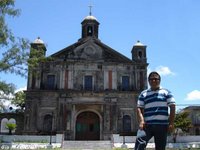 From Tigaon, I took a jeep to Goa which was PHP10. Goa had a large church with its courtyard dissected by a road which passed in front of the structure. The original gates and walls were still standing. But there was a permanent concrete structure in the middle of the patio (the one used for the salubong which had four posts each with balconies for angels and a hole at the top for the main angel to be lowered from) blocking the view from the main gate. I would later learn that this was a staple structure for churches in Camarines Sur. The sad part was that some were right smack in front of the church such as in Lagonoy, when they could have been put on the side.
From Tigaon, I took a jeep to Goa which was PHP10. Goa had a large church with its courtyard dissected by a road which passed in front of the structure. The original gates and walls were still standing. But there was a permanent concrete structure in the middle of the patio (the one used for the salubong which had four posts each with balconies for angels and a hole at the top for the main angel to be lowered from) blocking the view from the main gate. I would later learn that this was a staple structure for churches in Camarines Sur. The sad part was that some were right smack in front of the church such as in Lagonoy, when they could have been put on the side.
 I had lunch in Goa and good thing there was an air-conditioned fastfood joint there. From Goa, I took a bus to Lagonoy. That was PHP8. Along the way, I saw the church in San Jose and decided I would stopover on the way back. As I mentioned, Lagonoy had a very charming church which was constructed amid a backdrop of mountains. The old gates and walls were still standing and it would have been a classic example of the lay-out of colonial churches had it not been for that concrete canopy they constructed right at the gates, in front of the church itself. Again, the inside was renovated! So it was off to San Jose.
I had lunch in Goa and good thing there was an air-conditioned fastfood joint there. From Goa, I took a bus to Lagonoy. That was PHP8. Along the way, I saw the church in San Jose and decided I would stopover on the way back. As I mentioned, Lagonoy had a very charming church which was constructed amid a backdrop of mountains. The old gates and walls were still standing and it would have been a classic example of the lay-out of colonial churches had it not been for that concrete canopy they constructed right at the gates, in front of the church itself. Again, the inside was renovated! So it was off to San Jose.
 Although it was not among the churches suggested to Gemma, I decided to stopover, attracted by the facade. Thus I was so surprised when I entered since it turned out to be the best-preserved of all the churches I visited in the past two days. Inside, I could easily distinguish the smell of age as I marveled at the well-preserved wall and ceiling murals (see photo below) the colors of which reminded so much of Tayabas. The San Jose Church definitely deserves to be declared a national historical landmark at the very least! What a shame if I decided to skip this church entirely!
Although it was not among the churches suggested to Gemma, I decided to stopover, attracted by the facade. Thus I was so surprised when I entered since it turned out to be the best-preserved of all the churches I visited in the past two days. Inside, I could easily distinguish the smell of age as I marveled at the well-preserved wall and ceiling murals (see photo below) the colors of which reminded so much of Tayabas. The San Jose Church definitely deserves to be declared a national historical landmark at the very least! What a shame if I decided to skip this church entirely!
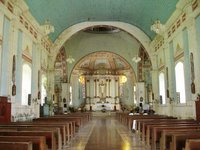 As I left, a funeral procession was about to enter the church and you could hear the play of the church bells. I remember that the tune played by the bells announced to the public a message, that someone was getting married, that it was fiesta time, that a male or female died and there was a requiem Mass, etc. and each had a particular tune.
As I left, a funeral procession was about to enter the church and you could hear the play of the church bells. I remember that the tune played by the bells announced to the public a message, that someone was getting married, that it was fiesta time, that a male or female died and there was a requiem Mass, etc. and each had a particular tune.
 From San Jose, I took a bus straight Naga City. It wasn't difficult to board one since they left Lagonoy quite regularly. It costed PHP40. The view along the way was also great since you had Mount Isarog on your right and Mount Iriga (below) on your left. While on the bus, it started to rain which was good since it brought down the temperature.
From San Jose, I took a bus straight Naga City. It wasn't difficult to board one since they left Lagonoy quite regularly. It costed PHP40. The view along the way was also great since you had Mount Isarog on your right and Mount Iriga (below) on your left. While on the bus, it started to rain which was good since it brought down the temperature.
 I arrived in Naga at about 3:30 p.m. and the first thing I did was to purchase a ticket back to Manila. This time I made sure to purchase the Philtranco Gold Service ticket since their executive buses had airline seats and were more spacious. It costs PHP200 more than the regular aircon bus at PHP800 plus PHP6 for insurance. The bus was going to leave at 9 p.m. so just enough time to explore Naga.
I arrived in Naga at about 3:30 p.m. and the first thing I did was to purchase a ticket back to Manila. This time I made sure to purchase the Philtranco Gold Service ticket since their executive buses had airline seats and were more spacious. It costs PHP200 more than the regular aircon bus at PHP800 plus PHP6 for insurance. The bus was going to leave at 9 p.m. so just enough time to explore Naga.
 When that was done, I took a tricycle from the terminal to the Naga Cathedral which had a large centuries old seminary building right beside it, the Holy Rosary Seminary. The Naga Cathedral was itself monumental. But inside, you could see that the interior had already been renovated, seemingly by the same group which is planning to make St. Peter's Basilicas out of the other Camarines churches. Indeed, St. Peter's is a work of art but we have our own Filipino church art which we must endeavor to preserve. Let's not try to erase what makes us uniquely Filipino.
When that was done, I took a tricycle from the terminal to the Naga Cathedral which had a large centuries old seminary building right beside it, the Holy Rosary Seminary. The Naga Cathedral was itself monumental. But inside, you could see that the interior had already been renovated, seemingly by the same group which is planning to make St. Peter's Basilicas out of the other Camarines churches. Indeed, St. Peter's is a work of art but we have our own Filipino church art which we must endeavor to preserve. Let's not try to erase what makes us uniquely Filipino.
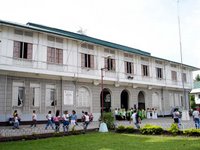 From the Naga Cathedral, I took another tricycle to the Peñafrancia Shrine. But along the way, I chanced upon the Camarines Sur National High School's Gabaldon building and told the driver to drop me off there instead. I had known from old photos that the old Pampanga High School building had a twin in Naga and finally, I found it! It was quite well-preserved so I immediately texted our friends in Pampanga that we now have a basis for the interior of the old PHS when we restore it since the buildings are close to 100% identical.
From the Naga Cathedral, I took another tricycle to the Peñafrancia Shrine. But along the way, I chanced upon the Camarines Sur National High School's Gabaldon building and told the driver to drop me off there instead. I had known from old photos that the old Pampanga High School building had a twin in Naga and finally, I found it! It was quite well-preserved so I immediately texted our friends in Pampanga that we now have a basis for the interior of the old PHS when we restore it since the buildings are close to 100% identical.
 From there, I walked to the shrine. A wedding has just finished and the floor was full of rose petals. The original image of Our Lady of Penafrancia was no longer there and had been transferred to a bigger church, the Peñafrancia Basilica Minore a few meters away. Except for the finish of the facade, the church and its convent remained mostly untouched. I noticed the gravestones on the floor had been smoothened out, obviously by the large number of devotees visiting the shrine and there was no longer a trace that a name used to be carved on them. Sad!
From there, I walked to the shrine. A wedding has just finished and the floor was full of rose petals. The original image of Our Lady of Penafrancia was no longer there and had been transferred to a bigger church, the Peñafrancia Basilica Minore a few meters away. Except for the finish of the facade, the church and its convent remained mostly untouched. I noticed the gravestones on the floor had been smoothened out, obviously by the large number of devotees visiting the shrine and there was no longer a trace that a name used to be carved on them. Sad!
From there, it was off to the Peñafrancia Basilica Minore which was another tricycle ride away. This was the second time I visited the church. There was a restaurant in the compound so I decided to have dinner there.
 I realized that I had forgotten to visit another site, the monument in downtown Naga dedicated to the Fifteen Martyrs of Bicol. So by the time I got there, it was dark. Nevertheless, I was able to take photos of this elegant monument. They don't make monuments like these nowadays.
I realized that I had forgotten to visit another site, the monument in downtown Naga dedicated to the Fifteen Martyrs of Bicol. So by the time I got there, it was dark. Nevertheless, I was able to take photos of this elegant monument. They don't make monuments like these nowadays.
It was then back to the station where I decided to wait it out at the airconditioned office of Philtranco. At least I was able to rest. I got on the bus expecting to get a good night's sleep. But I was rudely awakened somewhere in Tagkawayan, Quezon since we were driving along the worst roads I've ever seen with more potholes than craters on the moon. The rough roads and the zigzagging kept me awake for most of the southern Quezon leg. But I was able to sleep better as we neared Manila since the next thing I knew, the driver was waking me up since we were already in Pasay, and I was the only one left on the bus. It reminded me so much of my trip from Vientiane to Bangkok on executive class as well since I was in still in lalaland when we arrived in Bangkok.
Anyway, until the next trip. Do visit my travel photos at http://ivanhenares.multiply.com/photos and my heritage photos at http://photos.yahoo.com/ivanhenares since there are more photos of the sites I described in this entry as well as previous ones.
 The past three days have been dedicated to meetings and surveying of the heritage sites of San Fernando. We are one in a rare breed of cities in the country which are agressively pursuing heritage conservation. On Wednesday, we met with representatives of the San Fernando, Pampanga Heritage Foundation, Filipino-American Memorial Endowment, American Chamber of Commerce, Battling Bastards of Bataan and the Defenders of Bataan and Corregidor regarding the plans of the city to restore the San Fernando Train Station and to open a Death March memorial and museum in the site.
The past three days have been dedicated to meetings and surveying of the heritage sites of San Fernando. We are one in a rare breed of cities in the country which are agressively pursuing heritage conservation. On Wednesday, we met with representatives of the San Fernando, Pampanga Heritage Foundation, Filipino-American Memorial Endowment, American Chamber of Commerce, Battling Bastards of Bataan and the Defenders of Bataan and Corregidor regarding the plans of the city to restore the San Fernando Train Station and to open a Death March memorial and museum in the site. For those who are not yet aware of the significance of the said train station, it was the ending point of the long 102-kilometer walk from Mariveles, Bataan in April 1942. At the station, thousands of Filipino and American POWs were stuffed like sardines into box carts and transported to Capas, Tarlac. Anyway, expect more updates but the biggest hurdle is the slow response of the Philippine National Railways Corporation which is the owner of the said property.
For those who are not yet aware of the significance of the said train station, it was the ending point of the long 102-kilometer walk from Mariveles, Bataan in April 1942. At the station, thousands of Filipino and American POWs were stuffed like sardines into box carts and transported to Capas, Tarlac. Anyway, expect more updates but the biggest hurdle is the slow response of the Philippine National Railways Corporation which is the owner of the said property. Today, a survey team of the National Historical Institute arrived to inspect more houses for possible declaration. San Fernando is trying to increase its number of declared structures and glad to say, all the other house owners have already given their consent and are excited about the possible declaration. For one, the city will soon be granting real estate tax exemptions to all heritage house owners to encourage them to preserve their homes.
Today, a survey team of the National Historical Institute arrived to inspect more houses for possible declaration. San Fernando is trying to increase its number of declared structures and glad to say, all the other house owners have already given their consent and are excited about the possible declaration. For one, the city will soon be granting real estate tax exemptions to all heritage house owners to encourage them to preserve their homes. Among the strongest contenders is the Singian House which was built in the mid-19th century. It could in fact be the oldest surviving house in San Fernando. The house is very well-maintained by its current owners. If it was indeed built in the 1850s, I suspect its original owner was Don Bernardino Singian de Miranda, a former gobernadorcillo of San Fernando from whom many of San Fernando's prominent families trace their roots. Don Bernardino is the grandfather of eminent pre-war surgeon Dr. Gregorio Singian.
Among the strongest contenders is the Singian House which was built in the mid-19th century. It could in fact be the oldest surviving house in San Fernando. The house is very well-maintained by its current owners. If it was indeed built in the 1850s, I suspect its original owner was Don Bernardino Singian de Miranda, a former gobernadorcillo of San Fernando from whom many of San Fernando's prominent families trace their roots. Don Bernardino is the grandfather of eminent pre-war surgeon Dr. Gregorio Singian. Another strong contender is the charming Victorian-inspired Hizon House along Consunji Street. It was built by Don Teodoro Santos, Jr. and Dona Africa Ventura and later purchased by Maria Hizon who served as a nurse in the Philippine Revolutionary Army. It is currently owned by the heirs of her nephew, Don Augusto Hizon.
Another strong contender is the charming Victorian-inspired Hizon House along Consunji Street. It was built by Don Teodoro Santos, Jr. and Dona Africa Ventura and later purchased by Maria Hizon who served as a nurse in the Philippine Revolutionary Army. It is currently owned by the heirs of her nephew, Don Augusto Hizon.























